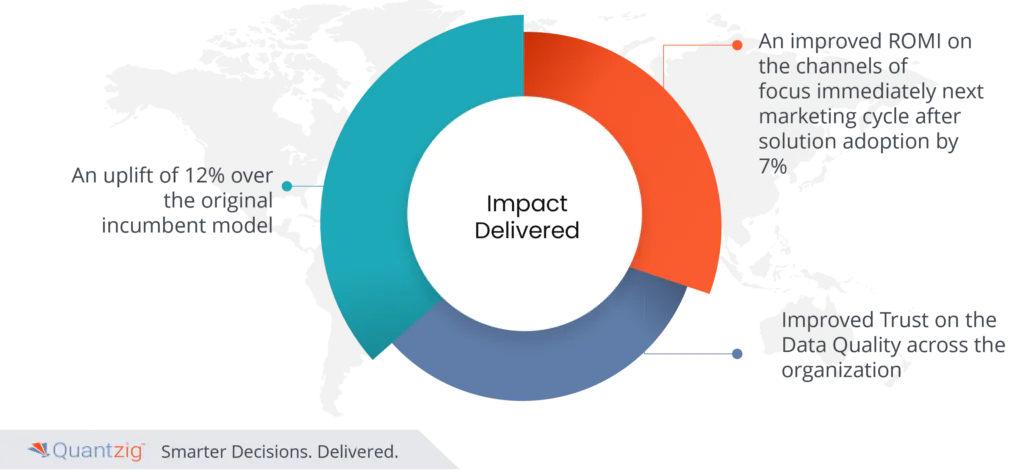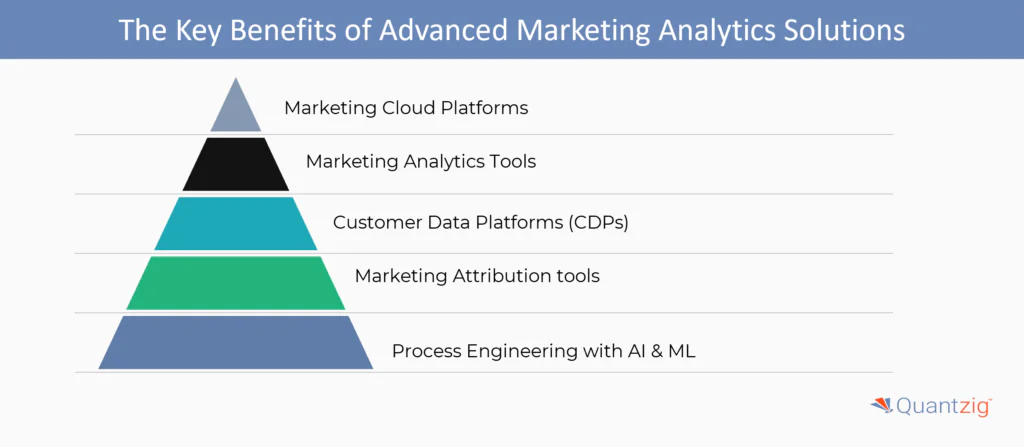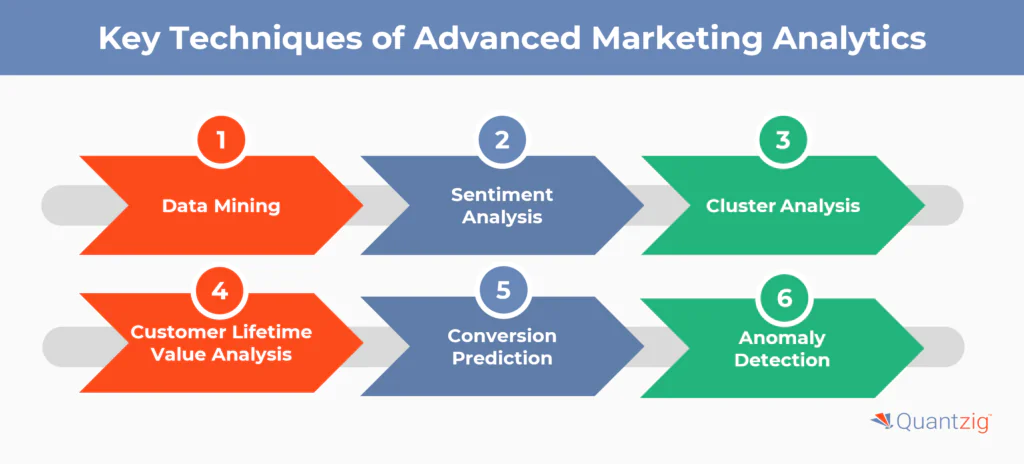Written By: Sudeshna Ghosh
Table of Contents
Key Takeaways for Advanced Marketing Analytics Solutions
- Quantzig’s advanced MMM + MTA solution helped a US-based CPG company achieve an uplift of 12% over the original incumbent model, and to improve ROMI on the channels of focus immediate next marketing cycle after the solution adoption by 7%.
- Marketing analytics tools use advanced artificial intelligence and machine learning to precisely calculate marketing return on investment, forecast how customers will act in the future, and enable customized experiences for each customer across all advertising platforms.
- The scattering of data across different departments and systems, creates isolated data pockets (silos) by the increase in marketing analytics tools, makes it hard to get a complete picture of customer behavior and campaign results.
- Quantzig helps companies boost marketing analytics effectiveness by systemizing data operations, incorporating cutting-edge software tools, and delivering complete end-to-end solutions for collecting, processing, and examining data from various sources.
Introduction
The rise of advanced marketing analytics solutions has transformed the process businesses operate, offering data-driven decision-making capabilities and in-depth insights. By harnessing the power of advanced marketing analytics tools, businesses can now assess potential risks, optimize processes, and forecast current market trends with unparalleled precision. This case study will provide you with the significance of advanced marketing analytics solutions and how Quantzig helped a CPG multinational client to experience an uplift of 12% over the original incumbent model, and to improve ROMI on the channels of focus immediate next marketing cycle after the solution adoption by 7%.
Book a demo to experience the meaningful insights we derive from data through our analytical tools and platform capabilities. Schedule a demo today!
Request a Free DemoQuantzig’s Advanced Marketing Analytics Solutions for a CPG Brand
| Client Details | A CPG multinational client headquartered in the USA with a diverse product portfolio. |
| Challenges Faced by The Client | Their current MMM was more traditional and outdated with a once-a-year planning approach and the inability to provide dynamic plans for digital channels and leverage client internal marketing performance data into solutions. |
| Solutions Offered by Quantzig | Quantzig helped the client with the MMM + MTA solution with model refresh with newer weekly data. We began building the intelligence layer followed by attribution models for channels that did not have a direct way of recognizing the share of revenue. We then identified the sensitivities, and efficient boundaries for channel spending with ROI Measurements and enabled a simulation tool kit for marketing analysts to explore different budgeting scenarios and channel allocation. |
| Impact Delivered | 1. An uplift of 12% over the original incumbent model, and 2. An improved ROMI on the channels of focus immediately next marketing cycle after solution adoption by 7%. |
Client Details
A CPG multinational client headquartered in the USA.
Challenges in Marketing Analytics Solutions Faced by the Client
The client is CPG Multinational with centralized budgeting and decentralized execution for Digital and non-digital channels. Their current MMM was more traditional analytics and outdated with a once-a-year planning approach and the inability to provide dynamic plans for digital channels and leverage client internal marketing performance data into solutions.
Advanced Marketing Analytics Solutions Offered by Quantzig for the Client:
Quantzig helped the client with the MMM + MTA solution with model refresh with newer weekly data and thereby more adaptive plans to take into consideration of recency effect at any time of the year and not just at the start of the annual marketing cycle.
We began building the intelligence layer followed by attribution models for channels that did not have a direct way of recognizing the share of revenue. We followed it with the calculation of baseline revenue and breakdown of overall revenue for channel-wise spread. We then identified the sensitivities, and efficient boundaries for channel spending with ROI Measurements and enabled a simulation tool kit for marketing analysts to explore different budgeting scenarios and channel allocation.
Impact Delivered using Quantzig’s Expertise:

- An uplift of 12% over the original incumbent model, and
- An improved ROMI on the channels of focus immediately next marketing cycle after solution adoption by 7%.
- Improved Trust on the Data Quality across the organization.
Also Read: Maximizing Marketing Budgets with Campaign ROI Analysis
Get started with your complimentary trial today and delve into our platform without any obligations. Explore our wide range of customized, consumption driven analytical solutions services built across the analytical maturity levels.
Start your Free Trial TodayImportance of Advanced Marketing Analytics Solutions
Modern marketing analytics solutions assist in gauging the return on investment (ROI) for marketing efforts with greater precision. This enables companies to determine effective and ineffective initiatives, optimizing the influence of each marketing dollar used. Cutting-edge artificial intelligence, machine learning technologies, and statistical methods can rapidly process immense data volumes to forecast customer actions and market shifts, expediting actionable insights systematically and at scale with high accuracy. Brands can leverage this to deliver more tailored customer experiences across all paid, earned, and owned channels at the individual consumer and session levels, promptly adapting their marketing plans to changing customer needs and evolving market conditions.
What are the Potential Challenges While Implementing Advanced Marketing Analytics Solutions?
Marketing data tends to be dispersed across various departments and systems, forming separate data silos. This fragmentation of information makes it challenging to attain a comprehensive understanding of customer actions and marketing campaign results. Flawed or incomplete data can produce misleading takeaways. Moreover, the vast selection of marketing analytics platforms on the market can be daunting when attempting to choose the optimal solutions.
Furthermore, expanded data gathering brings with it the duty to safeguard customer privacy. Companies must guarantee adherence to data protection laws and foster customer confidence concerning the use of their information.
What are the Key Benefits of Advanced Marketing Analytics Solutions?

The implementation of advanced marketing analytics can be approached as a general framework, but the specifics need to be tailored for each situation. There is no one universal approach that will work for every company. The appropriate selection of tools, sales and marketing analytics techniques, data collection methods, and solutions depends on the marketing strategies and needs of each organization in each industry. These details need to be evaluated on a case-by-case basis. However, there are some general factors to consider when pursuing a marketing analytics transformation for consumer-facing businesses. The overall process should be adapted based on the unique goals and circumstances of each company.
1. Marketing Cloud Platforms:
Brands should concentrate on an all-inclusive platform that brings together all data and tools in one central location, including marketing automation, customer relationship management (CRM), prescriptive analytics, regression analytics, and advanced analytics capabilities. The goal would be to consolidate your data, streamline workflows, and deliver powerful insights – all within a single unified platform.
2. Marketing Analytics Tools:
These are specialized tools that center on thorough data analysis through intelligence workbenches and smart insights. They connect to diverse historical data sources, facilitate advanced analysis, enable complex data manipulation and model building, and provide decision support for manual or automated execution.
3. Customer Data Platforms (CDPs):
It compiles data about customers from various sources like website visits, social media engagement, and purchase records. This creates a complete profile for each customer, allowing you to customize marketing efforts and calculate customer lifetime value.
4. Marketing Attribution tools:
It tracks the different touchpoints in a customer’s journey to see which ones influence conversions. This provides insights into how much each marketing channel contributes to sales. You can then optimize budgets and prioritize high-impact channels.
5. Process Engineering with AI & ML:
These are advanced marketing analytics solutions that leverage machine learning and AI (Artificial Intelligence) algorithms to predict customer behavior, automate tasks, and personalize marketing campaigns in real time.
Key Techniques of Advanced Marketing Analytics: Diving Deep
1. Data Mining:
Data mining is an essential component of advanced data analysis. It involves a methodical process of discovering patterns, connections, and insights within large data sets. Using algorithms and statistical methods, it brings hidden information that may not be readily visible at first glance.
Data mining enables digging into customer actions, campaign results, and market movements. For example, by examining transaction records, companies can pinpoint buying behaviors that could inform product suggestions or chances to upsell. Overall, data mining delivers the ability to probe deeply into customer conduct, campaign performance, and market inclinations. It is a foundational pillar of advanced analytics.
2. Sentiment Analysis:
Sentiment analysis, also known as opinion mining, is the use of natural language processing and computational linguistics to determine the emotional undertone behind words. This method is used to comprehend sentiments, emotions, or viewpoints toward a brand, product, or subject from digital conversations.
Sentiment analysis provides a more in-depth understanding of your target audience. It enables brands to capture the emotional impact of their campaigns, products, or services. By evaluating positive, negative, or neutral tones in customer feedback, reviews, or social media mentions, businesses can refine their strategies.
For example, a product launch getting mixed critiques can be quickly addressed by modifying messaging or solving product issues. Similarly, amplifying positive sentiments can boost brand image and cultivate trust.
3. Cluster Analysis:
The idea of grouping things together naturally fits with marketing. Clustering is all about aiding marketers in dividing prospects and customers into natural segments. Unique content, campaigns, and offers can then be made for each segment.
Cluster analysis, also known as clustering, is a method used to categorize data points (or objects) based on shared traits, making sure that entities within the same group are more alike than those in other groups. In marketing, this technique is often used to separate audiences by behavior, preferences, or demographics.
By utilizing cluster analysis, businesses can uncover deeper insights into their customer base. For example, a cluster showing frequent online shoppers with a liking for environmentally friendly products could inspire a targeted green marketing campaign. On the flip side, understanding a cluster displaying customers with decreasing engagement can prompt timely retention efforts.
4. Customer Lifetime Value Analysis:
Marketing to prospects who are unlikely to become valuable customers can waste a lot of money. But how can you identify who will be the most profitable over time?
Customer lifetime value (CLV) analysis calculates the total net profit you can expect from a customer relationship. It goes beyond one-time sales to encompass the whole future value of having that customer.
While single transaction metrics show immediate income, CLV analysis provides a big picture view of long-term profitability. It emphasizes the importance of building lasting relationships, since satisfied, loyal customers will continue to purchase and recommend your brand.
Advanced analytics incorporate factors like customer churn, discounts, and retention costs to develop a more nuanced CLV. Predictive modeling can further refine the analysis by accounting for possible future behaviors and market changes.
In summary, CLV analysis quantifies the projected holistic worth of customers to guide acquiring and retaining the most valuable long-term relationships.
5. Сonversion Prediction:
Conversion forecasting utilizes data-driven models to predict if a potential customer will complete a preferred action, like making a purchase, signing up for a newsletter, or engaging with content. By evaluating historical data and user behavior, this method provides a probabilistic projection of future conversion occurrences.
To have a better chance of success, you’ll need a lot of historical data regarding user behavior. Conversion forecasting incorporates granular user information. It evaluates patterns from comparable users, their interaction history, and even subtle hints like time elapsed on pages or mouse movements, translating these into actionable predictions.
Conversion forecasting can be leveraged to streamline retargeting efforts. Rather than generic retargeting campaigns, marketers can curate personalized messaging based on predicted conversion paths.
6. Anomaly Detection:
As a marketer, you must stay alert so that as soon as something is not working as anticipated, you can quickly take remedial action.
Anomaly detection is a method that pinpoints patterns in information that are irregular or don’t match expected conduct. It’s like a watchful sentry, signaling sudden spikes in activity, unforeseen declines in deals, or variations that stray from the standard.
While some fluctuations in information are normal because of seasonal shifts or known market patterns, anomalies are those events that are unforeseen and could show potential issues or opportunities. They are the outliers that may signify an operational problem, a successful marketing effort, or even external factors like a competitor’s actions.
Anomaly detection uses complex algorithms, frequently based in machine learning. These algorithms are prepared to recognize ‘normal’ designs and can then flag deviations as anomalies. The more data they are exposed to, the better they get at differentiating the commonplace from the significant.
How does Quantzig Help Implement Advanced Marketing Analytics?
Quantzig facilitates the implementation of sophisticated marketing analytics by automating mundane data tasks and integrating modern software into your processes. Manual data handling diverts time from analysis to routine operations and exposes insights to inaccuracies from human error. With Quantzig, you can focus your efforts on deriving value from your data rather than preparing it for analysis. The platform handles the tedious data wrangling and pipelining automatically so you can devote your energy to higher-level analysis and optimization. By leveraging our automation and integration capabilities, you enable more advanced marketing analytics without the downsides of manual workflows.
We provide companies with automated marketing data processing and advanced marketing analytics insights without needing repetitive manual work. Our end-to-end marketing analytics solution gathers data from over 500 marketing and sales platforms, prepares the data for analysis, and sends it to your chosen destination like a data warehouse, business intelligence data visualization tools, or an analytics platform. With intuitive dashboards included, you gain a new perspective on your marketing efforts to optimize your marketing campaigns efficiently.
Also Read: Track Business Progress with Marketing Analytics Dashboard
Experience the advantages firsthand by testing a customized complimentary pilot designed to address your specific requirements. Pilot studies are non-committal in nature.
Request a Free PilotConclusion
Unlike basic marketing analytics, advanced analytics provide data that more closely reflects real-world events. The data offers a more precise overview of reality that can inform more impactful business decisions.
Advanced marketing analytics enables B2B (Business-to-Business) and B2C (Business-to-Consumer) businesses to more accurately forecast future occurrences and identify trends. This type of analytics also generates more reliable insights, drawing from a broader range of precise and credible data sources.





